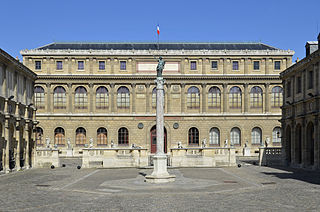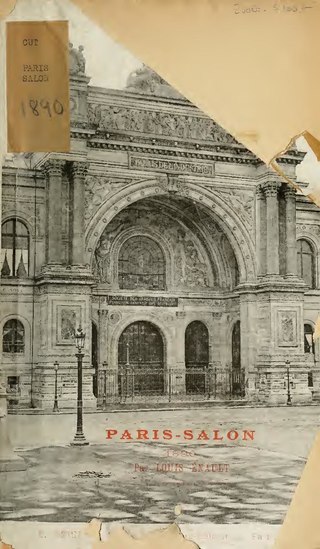
Louis Cretey, formerly known as Pierre-Louis Cretey (c.1635, in Lyon - after 1702), was a French baroque painter and one of the leading masters in the Lyonnaise school. [1]

Louis Cretey, formerly known as Pierre-Louis Cretey (c.1635, in Lyon - after 1702), was a French baroque painter and one of the leading masters in the Lyonnaise school. [1]
Little is known about the early life of this artist. Records place Cretey in Rome from 1661 to 1679, then Modena in 1679 - another place he probably worked was Parma. He then returned to France and spent most of his subsequent career in Lyon, gaining renown from the 1680s onwards as a history painter and for producing altarpieces like The Road to Emmaus (Lyon, Ste Blandine). He became Thomas Blanchet's main collaborator, working with him on many decorative schemes such as work at the Palais de Roanne (now Palais de Justice).

From 1684 to 1686, Cretey created a series of paintings for the refectory of the Benedictine abbey of Saint-Pierre, including The Last Supper, The Multiplication of the Loaves, The Assumption of the Virgin, The Ascension of Christ and an The prophet Elias. These refectory paintings (now in the Musée des beaux-arts de Lyon) show groups of figures vividly lit in front of dark backgrounds, recalling not only 16th-century Venetian pre-baroque prototypes but also Simon Vouet's early Italian works and their chiaroscuro. [2]
The Musée des Beaux-Arts de Lyon holds a fine collection of this artist's works. Other museums displaying paintings by Cretey include the Musei Vaticani, the Musée du Louvre, the Detroit Institute of Art and the Musée des Beaux-Arts de Rennes.

Pierre Puvis de Chavannes was a French painter known for his mural painting, who came to be known as "the painter for France". He became the co-founder and president of the Société Nationale des Beaux-Arts, and his work influenced many other artists, notably Robert Genin, and he aided medallists by designs and suggestions for their works. Puvis de Chavannes was a prominent painter in the early Third Republic. Émile Zola described his work as "an art made of reason, passion, and will".

Charles Le Brun was a French painter, physiognomist, art theorist, and a director of several art schools of his time. He served as a court painter to Louis XIV, who declared him "the greatest French artist of all time". Le Brun was a dominant figure in 17th-century French art and was influenced by Nicolas Poussin.

The Beaux-Arts de Paris, formally the École nationale supérieure des beaux-arts, is a French grande école whose primary mission is to provide high-level fine arts education and training. The art school, which is part of the Paris Sciences et Lettres University, is located on two sites: Saint-Germain-des-Prés in Paris, and Saint-Ouen.

Simon Vouet was a French painter who studied and rose to prominence in Italy before being summoned by Louis XIII to serve as Premier peintre du Roi in France. He and his studio of artists created religious and mythological paintings, portraits, frescoes, tapestries, and massive decorative schemes for the king and for wealthy patrons, including Richelieu. During this time, "Vouet was indisputably the leading artist in Paris," and was immensely influential in introducing the Italian Baroque style of painting to France. He was also, according to Pierre Rosenberg, "without doubt one of the outstanding seventeenth-century draughtsmen, equal to Annibale Carracci and Lanfranco."

Léon Joseph Florentin Bonnat was a French painter, Grand Officer of the Légion d'honneur, art collector and professor at the Ecole des Beaux Arts.

Louis-Ernest Barrias was a French sculptor of the Beaux-Arts school. In 1865 Barrias won the Prix de Rome for study at the French Academy in Rome.

French art consists of the visual and plastic arts originating from the geographical area of France. Modern France was the main centre for the European art of the Upper Paleolithic, then left many megalithic monuments, and in the Iron Age many of the most impressive finds of early Celtic art. The Gallo-Roman period left a distinctive provincial style of sculpture, and the region around the modern Franco-German border led the empire in the mass production of finely decorated Ancient Roman pottery, which was exported to Italy and elsewhere on a large scale. With Merovingian art the story of French styles as a distinct and influential element in the wider development of the art of Christian Europe begins.

Jean Restout the Younger was a French artist, who worked in painting and drawing. Although little remembered today, Restout was well-respected by his contemporaries for his religious compositions.

Société Nationale des Beaux-Arts was the term under which two groups of French artists united, the first for some exhibitions in the early 1860s, the second since 1890 for annual exhibitions.

Laurent-Honoré Marqueste was a French sculptor in the neo-Baroque Beaux-Arts tradition. He was a pupil of François Jouffroy and of Alexandre Falguière. Marqueste won the Prix de Rome in 1871.

Fleury François Richard, sometimes called Fleury-Richard, was a French painter of the Lyon School. A student of Jacques-Louis David, Fleury-Richard and his friend Pierre Révoil were precursors of the Troubadour style.

The Museum of Fine Arts of Lyon is a municipal museum of fine arts in the French city of Lyon. Located near the Place des Terreaux, it is housed in a former Benedictine convent which was active during the 17th and 18th centuries. It was restored between 1988, and 1998, remaining open to visitors throughout this time despite the ongoing restoration works. Its collections range from ancient Egyptian antiquities to the Modern art period, making the museum one of the most important in Europe. It also hosts important exhibitions of art, for example the exhibitions of works by Georges Braque and Henri Laurens in the second half of 2005, and another on the work of Théodore Géricault from April to July 2006. It is one of the largest art museums in France.

Arnould de Vuez was a painter of Flemish origin active in Lille from 1680 to 1720.

Jacques Stella was a French painter, a leading exponent of the neoclassical style of Parisian Atticism.

Trophime Bigot (1579–1650), also known as Théophile Bigot, Teofili Trufemondi, the Candlelight Master, was a French painter of the Baroque era, active in Rome and his native Provence.

Jacques-Henri Sablet was a Swiss-French painter, part of a family of artists of Swiss origin. He was also known as Franz der Römer, Giacomo Sablez, Giacomo Sablé, Jacob Henry Sablet, Sablet le Jeune, Sablet le Romain or le peintre du Soleil.

Pieter van Mol or Peter van Mol was a Flemish painter known for his history paintings of religious subject matter, and to a lesser extent for his allegorical compositions, genre scenes and portraits. His style was profoundly influenced by Rubens, Abraham Janssens and Artus Wolffort. He was court painter to the King and Queen of France.
Joseph Fortuné Séraphin Layraud was a French painter. There is no complete clearance as to the birth' and the death' dates. Some sources refer to 1833–1913. His range included historical scenes and figures, religious and mythological subjects, landscapes, and portraits of contemporaries.

Jean-François Bony was a French painter, draftsman, embroiderer, silk manufacturer, and flower painter. A talented artist, his designs include studies of a dress and mantle proposed for the wearing of Josephine de Beauharnais at the coronation of Napoleon. Bony was active before, during and after the French Revolution, also designing fabrics for Marie Antoinette, Empress Marie Louise and Napoleon himself.

Joseph Benoît Guichard was a French painter and art teacher who worked in a variety of styles.
![]() Media related to Paintings by Louis Cretey at Wikimedia Commons
Media related to Paintings by Louis Cretey at Wikimedia Commons